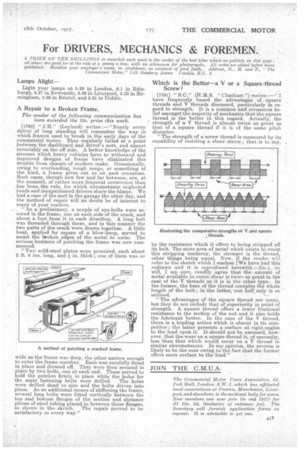For DRIVERS, MECHANICS & FOREMEN.
Page 23

If you've noticed an error in this article please click here to report it so we can fix it.
A PRIZE OF TEN SHILLINGS is awarded each week to the sender of the best letter which we publish an this page ; all other.? are paid for at the rate of a penny a line, with an. allowance for photographs. All notes are edited before being published. Mention your employer's name, in confidence, as evidence of good faith, Address, , M. and F., "The Commercial Motor," 7-15 Rosebery Avenu London, E.G. 1.
Lamps Alight—
Light your lamps at 5.28 in London, 6.1 in Edinburgh, 5.27 in Newcastle, 5.36 in Liverpool, 5.33 in Birmingham, 5.38 in Bristol, and 6.21 in Dublin.
A Repair to a Broken Frame.
The sender of the following communication has been awarded the Ws. prize this week, [1790] " J.H." (Leyland) writes :—" Nearly every driver of long standing will remember the way in which frames used to break in the early days of the commercial motor. They regularly failed at a point .between the dashboard and driver's seat, and almost invariably on the off side. A better knowledge of the .stresses which heavy vehicles have to withstand and improved designs of frame have eliminated this trouble from chassis of modern make. Occasionally, awing to overloading, rough usage, or something of the kind, a, frame gives out as on past occasions. Such cases, though now few and far between, are, at the moment, of rather more frequent occurrence than has been the rule, for which circumstance neglected roads and inexperienced drivers share the blame. We had a case of the sort in the garage the other day, and the method of repair will no doubt be of interest to many of your readers. " a preliminary, a couple of eye-bolts were secured in the frame, one on each side of the crack, and about a foot from it in each direction. A long bolt was threaded through these' and in this manner the two paits of the crack were drawn together. A little heat, applied by mons of a blow-lamp, served to assist the broken edges of the metal to unite. The serious business of patching the frame was now commenced.
"Two mild-steel plates were procured, each about 2 ft. 6 ins, long, and in. thick ; one of them was as
wide as the frame was deep, the other narrow enough to enter the frame member. Each was carefully fitted in place and dressed off. They were then secured in place by two bolts, one at each end. These served to hold the patches firmly in place while the holes for the main' fastening bolts were drilled. The holes were drilled dead to size and the bolts driven into place. As an additional means of stiffening the frame, several long bolts were fitted vertically between the top and bottom flanges of the section and distance pieces of steel tubing placed in between those flanges, as shown in the sketch. The repair proved to be satisfactory in every way."
Which is the -Better—a V or a Square-thread Screw ?
(1791] ." S.C." (H. M. S. "Chatham ") writes : —" I have frequently heard the advantages of square threads and V threads discussed, particularly in regard to strength. It is a common and erroneous belief amongst the majority of mechanics that the square thread is the better in this regard. Actually, the strength of a V thread is almost twice as great as that of a square thread if it is of the same pitch diameter.
"The strength of a screw thread is measured by its capability of resisting a sheer stress ; that is to say, by the resistance which it offers to being stripped off its bolt. The more area of metal which exists to resist this stripping tendency, the stronger is the thread, other things being equal. Now, if the reader will refer to the sketch which I enclose [We have had this redrawn and it is reproduced herewith.—En.j, he will, I am sure, readily agree that the amount of metal available to resist shear is twice as great in the case of the V threads as it is in the other type. In the former, the base of the thread occupies the whole
• length of the bolt ; in the latter, one half only is so "'utilized.
"The advantages of the square thread are many, but they do not include that of superiority in point of
• strength. A square thread offers a lower frictional resistance to the motion of the nut and it also holds the lubricant better. In the case of the V thread, 'there is a binding action which is absent in its competitor; the latter presents a surface at right-angles to the load upon it. It should not be assumed, however, that the wear on a, square thread is, of necessity, less than that which would occur on a V thread in similar circumstances. In my opinion, the reverse is likely to be the case owing to the fact that the former offers more surface to the load."
























